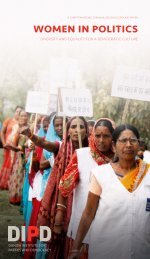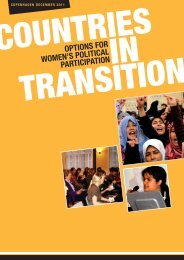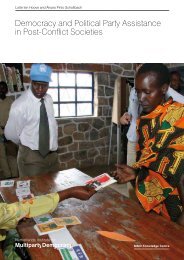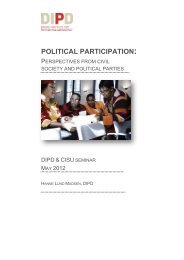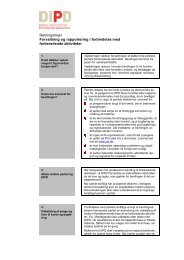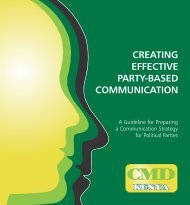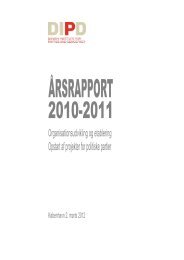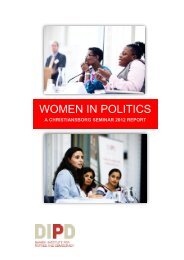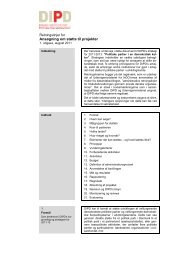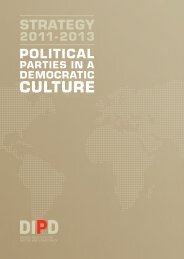Political Parties in Africa: Challenges for Sustained Multiparty
Political Parties in Africa: Challenges for Sustained Multiparty
Political Parties in Africa: Challenges for Sustained Multiparty
Create successful ePaper yourself
Turn your PDF publications into a flip-book with our unique Google optimized e-Paper software.
<strong>Political</strong> <strong>Parties</strong> <strong>in</strong> <strong>Africa</strong>: <strong>Challenges</strong> <strong>for</strong> Susta<strong>in</strong>ed <strong>Multiparty</strong> Democracy<br />
4. In Ethiopia, the struggle aga<strong>in</strong>st the dictatorial regime of Mengistu Haile<br />
Mariam (1974–91) culm<strong>in</strong>ated <strong>in</strong> the open<strong>in</strong>g up of the political space <strong>for</strong><br />
some competitive politics under the banner of ethnic-federalism. The country<br />
has no political parties <strong>in</strong> the common modern sense of the word, but there are<br />
ethnic organizations which compete <strong>for</strong> seats <strong>in</strong> the House of Representatives.<br />
S<strong>in</strong>ce its first multi-ethnic competitive election <strong>in</strong> 1994, Ethiopia has been<br />
ruled by a multi-ethnic coalition dom<strong>in</strong>ated by the Tigray People’s Liberation<br />
Front (TPLF), called the Ethiopian People’s Revolutionary Democratic<br />
Forces (EPRDF). The EPRDF consists of more than a dozen ethnicallybased<br />
liberation fronts, the most prom<strong>in</strong>ent among them be<strong>in</strong>g the Ethiopian<br />
People’s Democratic Movement (EPDM), the Oromo People’s Democratic<br />
Organization (OPDO), and the Ethiopian Democratic Officers Revolutionary<br />
Movement (ERODM). Despite criticisms of the quasi-democratic nature of<br />
this coalition, it has managed to generate a certa<strong>in</strong> degree of political stability<br />
by absorb<strong>in</strong>g large numbers of m<strong>in</strong>ority ethnic groups which would have hardly<br />
been represented <strong>in</strong> the House of Representatives if their votes had not been<br />
pooled together dur<strong>in</strong>g elections.<br />
5. South <strong>Africa</strong> is another case where a party coalition was <strong>in</strong>strumental dur<strong>in</strong>g<br />
the transition to multiparty democracy. The alliance between the <strong>Africa</strong>n<br />
National Congress (ANC), the Congress of South <strong>Africa</strong>n Trade Unions<br />
(COSATU) and the South <strong>Africa</strong>n Communist Party (SACP) was <strong>for</strong>ged as an<br />
<strong>in</strong>stitutional mechanism <strong>for</strong> creat<strong>in</strong>g an <strong>in</strong>clusive political mechanism to end<br />
apartheid and to see South <strong>Africa</strong> through to multiparty democracy. Kadima<br />
(2006) comments that the glues that keep the Tripartite Alliance together are<br />
probably the long tradition of work<strong>in</strong>g together under difficult circumstances,<br />
the power and job opportunities provided by the ANC, and the adoption of<br />
and adhesion by some key leaders of COSATU and SACP themselves to neoliberalism<br />
ideology to the detriment of the socialist ideals. Despite discom<strong>for</strong>t<br />
with some ANC policies, the Tripartite Alliance decided to rema<strong>in</strong> together<br />
and <strong>in</strong>fluence each other from <strong>in</strong>side. In the same tradition, South <strong>Africa</strong>’s first<br />
government of national unity was a coalition between the ANC, the National<br />
Party (NP) and the Inkatha Freedom Party (IFP). The Democratic Alliance<br />
(DA) was <strong>for</strong>med <strong>in</strong> June 2000 and comprised <strong>in</strong>itially the Democratic Party<br />
(DP), the New National Party (NNP, the <strong>for</strong>mer NP), and the Federal Alliance.<br />
The split of the Alliance <strong>in</strong> 2003 <strong>in</strong>to a number of squabbl<strong>in</strong>g factions revealed<br />
the <strong>in</strong>ability of the opposition parties to unite <strong>in</strong> the face of ANC–Tripartite<br />
political dom<strong>in</strong>ance. In 2003, the ANC and the NNP supported an item of<br />
legislation on floor-cross<strong>in</strong>g, which the smaller political parties considered<br />
detrimental to democracy and a source of <strong>in</strong>stability. In the case of South <strong>Africa</strong><br />
we notice a sense of maturity <strong>in</strong> terms of temporary as well as long-term partyto-party<br />
partnerships.



